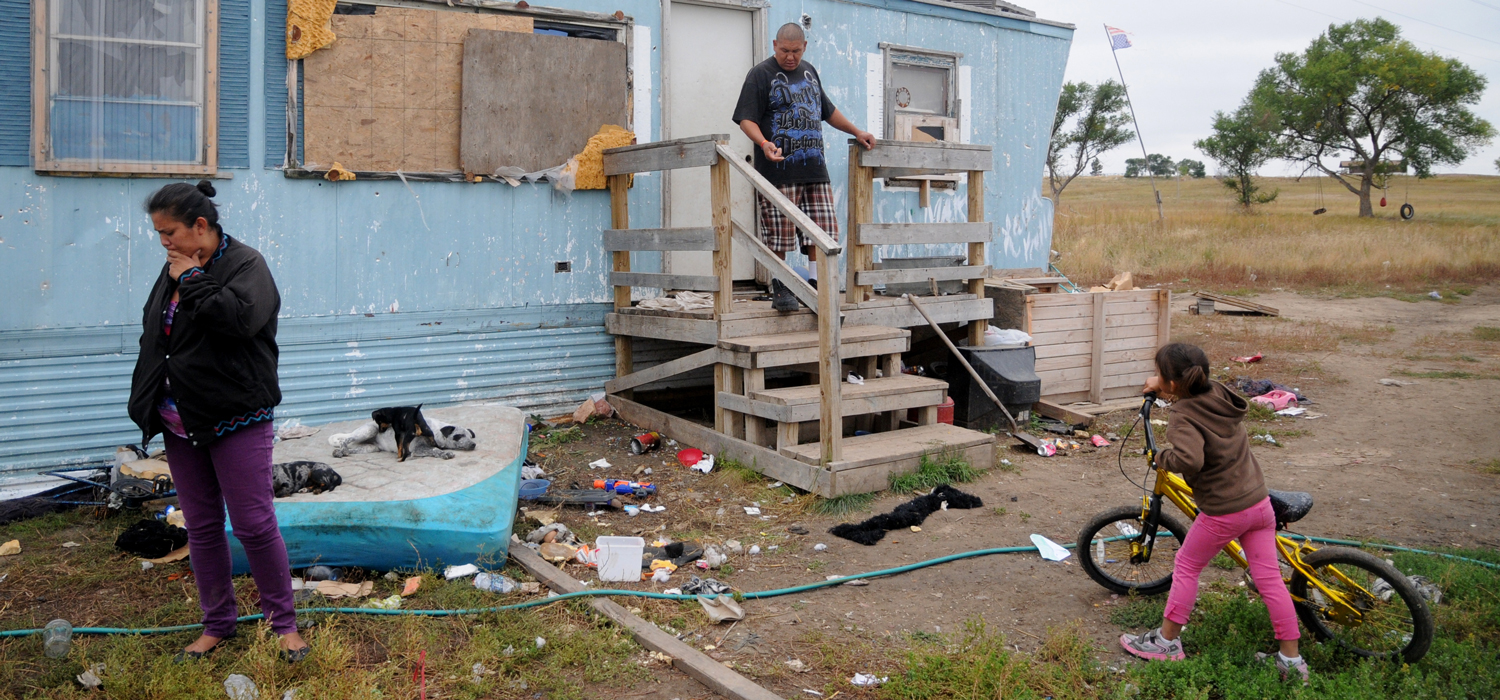
<p>In this Wednesday, Sept. 30, 2015, photo, Natasha Cuny, left, her boyfriend, Raymond Eagle Hawk, center, and their daughter, Kimimila Eagle Hawk, right, stand outside Raymond Eagle Hawk's mother's trailer in Wounded Knee, S.D., on the Pine Ridge Indian Reservation. Cuny, Raymond Eagle Hawk and their daughter live next door in a shed. Photo by James Nord/AP.</p>
Many are justifiably concerned over what President Trump’s 2018 budget proposal, which cuts the US Department of Housing and Urban Development’s budget by $6.2 billion, would mean for America’s poor. But one critical aspect of this problem has received little coverage: how spending cuts will affect Native American communities, who already face significant housing challenges. The data show that Native Americans experience worse housing conditions and a higher incidence of homelessness than the US population overall.
Our recent assessment of Native American housing conditions showed that homelessness affects nearly all tribal areas. Nationally, 99.8 percent of tribal housing officials reported that doubling up (i.e., taking in family and friends who would otherwise risk homelessness) was a problem in their tribal areas, and 88 percent said households experience literal homelessness (i.e., sleeping on the street, in emergency shelter, or someplace not meant for human habitation).
Because homelessness primarily takes the form of doubling up rather than sleeping on the street, homelessness in Indian Country is less conspicuous than in other areas. As one person we interviewed put it,
People go from one family member’s home to another. Everyone’s homeless around here, but they just stay with family members and extended families until they get kicked out. It’s not good—they are not living in the street, but it’s still not good.
Designated homeless services are also less common in tribal areas. Although homelessness affects nearly all tribal areas, only 46 percent of the tribal housing officials we surveyed noted that people their community use homeless shelters, and only 11 of the 22 tribal areas we visited had a shelter within their tribal area boundaries.
How large is the homeless population on tribal lands?
Although we do not have estimates of the number of literally homeless Native Americans living on tribal lands, we know that Native Americans tend to be overrepresented in the literally homeless population. About 1 in 200 people who identify American Indian and Alaska Native (AIAN) as their only race is homeless, compared with 1 in 1,000 people in the US population overall.
Our household survey in Indian Country indicates that doubling up often occurs to prevent literal homelessness. Seventeen percent of AIAN households in tribal areas include doubled-up members. Though only 19 percent of household heads would ask those people to leave, 80 percent say they think those people would prefer to leave if they could. We estimate that between 42,100 and 84,700 AIAN people (4 to 7 percent of the population) would be homeless if a friend or family member had not taken them in.
What do we need to solve the problem?
Despite this widespread problem, supports for affordable housing and homeless services in Indian Country are insufficient to meet the need. In our visits to 22 tribal areas, respondents tied homelessness to the lack of affordable housing stock, an issue directly connected to federal funding decisions.
Funding levels for the Indian Housing Block Grant (IHBG), the primary mechanism for affordable housing provision in Indian Country, have oscillated between $600 and $650 million since it began in 1998. But inflation has eroded the real value of these dollars to roughly a third of their 1998 value.
The Native American population living on tribal lands has also grown since 1998. Because funding has not kept pace with that growth, the nominal per capita allocation has fallen from $573 in 1999 to $386 in 2014.
The consequences of this diminishing investment are evident in the rates of AIANs using housing assistance. On tribal lands, 23 percent of Native households are extremely poor (i.e., income below 50 percent of the federal poverty level), which is nearly four times the national rate (6.6 percent). But despite these high poverty rates, only 12 percent of AIAN households reported living in assisted housing.
Though the administration has yet to release IHBG funding specifics, early budget reports suggest the administration is considering cutting IHBG funding by $150 million, despite the high need. Such a step would plunge funding levels to about half their 1998 value in real terms.
To solve the homelessness problem in Indian Country, policymakers should not cut funding. Instead, they should increase resources for affordable housing development and resources for tribes to provide for homeless families.
Let’s build a future where everyone, everywhere has the opportunity and power to thrive
Urban is more determined than ever to partner with changemakers to unlock opportunities that give people across the country a fair shot at reaching their fullest potential. Invest in Urban to power this type of work.